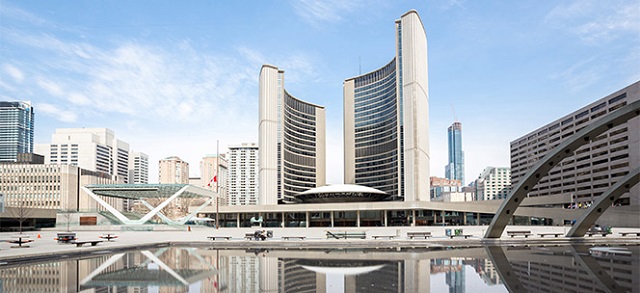Economy
Taxpayers Federation: Canada’s largest city overpaying for construction $350 million a year

From the Canadian Taxpayers Federation
Author: Jay Goldberg
Favouring unions costs taxpayers dearly
They say less is more, especially when it comes to budgeting. Apparently, Toronto Mayor Olivia Chow never got the memo.
Canada’s largest city keeps overpaying on construction projects, to the tune of $350 million a year. The reason, in many cases, is that only union-affiliated firms need apply.
With modest construction contracting reform, Toronto could save a bundle and see property taxes frozen for 2025.
Over the past two years, Toronto politicians voted to increase property taxes by a whopping 18 per cent. Last year’s increase alone was 9.5 per cent.
Because of these massive property tax increases, many families were pushed to the brink.
Property tax bills for most Torontonians soared by hundreds of dollars over the past two years.
Yet so much of this pain could have been avoided with a little common-sense policymaking.
Would you refuse to even consider quotes from a non-unionized company? Or would you get quotes from everyone and then make your decision?
To nearly everyone on the planet other than Toronto’s zany politicians, the choice is obvious.
But when you’re a Toronto politician spending other people’s money, apparently open competition to find the best deal isn’t a priority.
Right now, Toronto uses a closed-tendering approach to award contracts for some of the city’s most expensive construction projects. That means only a handful of companies associated with a small group of unions can bid on those jobs.
Cardus, a non-partisan thinktank, released a report last year projecting Toronto was poised to award $1.7 billion in construction projects through a closed tendering process in 2023. Because Toronto only allows a small number of unionized construction companies to bid on those jobs, the cost goes up.
In fact, Cardus estimated Toronto taxpayers were set to overpay on construction projects in 2023 to the tune of $350 million due to a lack of competition.
Closed tendering used to be the norm in Ontario. Every city across the province overpaid on construction projects to cater to big unions.
That all changed in 2019, when the Ford government passed legislation allowing municipalities to open up the construction contracting process to real competition.
Sadly, Toronto has thus far chosen not to take advantage of the Ford government’s legislative reforms to save a boatload of cash.
But nearby cities sure have.
Consider the example of Hamilton.
Hamilton was one of the first cities in Ontario to take advantage of the Ford government’s reforms. Cardus estimates Hamilton is saving 21 per cent on its construction projects because the city opened up its contracting process. This single reform did a great deal to improve the city’s bottom line.
Yet Toronto politicians appear stuck in the past. During last year’s mayoral by-election, only two candidates, Councillor Brad Bradford and Anthony Furey, pledged to follow Hamilton in reforming construction contracts.
There has been no indication from Chow, who won that by-election, that this common-sense reform is even on the table.
Last year, Chow and council increased property taxes by 9.5 per cent, the highest property tax hike in Toronto’s history.
Had Chow implemented construction reform and saved the $350 million Cardus pointed to, last year’s property tax increase could have been wiped out entirely.
Think about that. Chow had a choice: save money through competitive bidding or hammer taxpayers with a huge tax hike.
The mayor picked the tax hike.
To break the cycle of massive property tax hikes, it’s high time Toronto looked at construction contract reform.
Taxpayers shouldn’t put up with politicians overpaying on construction contracts to the tune of hundreds of millions of dollars a year, only to see those same politicians turn around and impose record property tax hikes.
This isn’t just a problem restricted to Toronto: taxpayers from British Columbia to Quebec themselves face similar anti-competitive policies at the provincial level.
It’s time for politicians to put taxpayers, not unions, first.
Chow should implement common-sense construction contracting reforms to head off a massive property tax increase in 2025.
Business
Carney government needs stronger ‘fiscal anchors’ and greater accountability

From the Fraser Institute
By Tegan Hill and Grady Munro
Following the recent release of the Carney government’s first budget, Fitch Ratings (one of the big three global credit rating agencies) issued a warning that the “persistent fiscal expansion” outlined in the budget—characterized by high levels of spending, borrowing and debt accumulation—will erode the health of Canada’s finances and could lead to a downgrade in Canada’s credit rating.
Here’s why this matters. Canada’s credit rating impacts the federal government’s cost of borrowing money. If the government’s rating gets downgraded—meaning Canadian federal debt is viewed as an increasingly risky investment due to fiscal mismanagement—it will likely become more expensive for the government to borrow money, which ultimately costs taxpayers.
The cost of borrowing (i.e. the interest paid on government debt) is a significant part of the overall budget. This year, the federal government will spend a projected $55.6 billion on debt interest, which is more than one in every 10 dollars of federal revenue, and more than the government will spend on health-care transfers to the provinces. By 2029/30, interest costs will rise to a projected $76.1 billion or more than one in every eight dollars of revenue. That’s taxpayer money unavailable for programs and services.
Again, if Canada’s credit rating gets downgraded, these costs will grow even larger.
To maintain a good credit rating, the government must prevent the deterioration of its finances. To do this, governments establish and follow “fiscal anchors,” which are fiscal guardrails meant to guide decisions regarding spending, taxes and borrowing.
Effective fiscal anchors ensure governments manage their finances so the debt burden remains sustainable for future generations. Anchors should be easily understood and broadly applied so that government cannot get creative with its accounting to only technically abide by the rule, but still give the government the flexibility to respond to changing circumstances. For example, a commonly-used rule by many countries (including Canada in the past) is a ceiling/target for debt as a share of the economy.
The Carney government’s budget establishes two new fiscal anchors: balancing the federal operating budget (which includes spending on day-to-day operations such as government employee compensation) by 2028/29, and maintaining a declining deficit-to-GDP ratio over the years to come, which means gradually reducing the size of the deficit relative to the economy. Unfortunately, these anchors will fail to keep federal finances from deteriorating.
For instance, the government’s plan to balance the “operating budget” is an example of creative accounting that won’t stop the government from borrowing money each year. Simply put, the government plans to split spending into two categories: “operating spending” and “capital investment” —which includes any spending or tax expenditures (e.g. credits and deductions) that relates to the production of an asset (e.g. machinery and equipment)—and will only balance operating spending against revenues. As a result, when the government balances its operating budget in 2028/29, it will still incur a projected deficit of $57.9 billion when spending on capital is included.
Similarly, the government’s plan to reduce the size of the annual deficit relative to the economy each year does little to prevent debt accumulation. This year’s deficit is expected to equal 2.5 per cent of the overall economy—which, since 2000, is the largest deficit (as a share of the economy) outside of those run during the 2008/09 financial crisis and the pandemic. By measuring its progress off of this inflated baseline, the government will technically abide by its anchor even as it runs relatively large deficits each and every year.
Moreover, according to the budget, total federal debt will grow faster than the economy, rising from a projected 73.9 per cent of GDP in 2025/26 to 79.0 per cent by 2029/30, reaching a staggering $2.9 trillion that year. Simply put, even the government’s own fiscal plan shows that its fiscal anchors are unable to prevent an unsustainable rise in government debt. And that’s assuming the government can even stick to these anchors—which, according to a new report by the Parliamentary Budget Officer, is highly unlikely.
Unfortunately, a federal government that can’t stick to its own fiscal anchors is nothing new. The Trudeau government made a habit of abandoning its fiscal anchors whenever the going got tough. Indeed, Fitch Ratings highlighted this poor track record as yet another reason to expect federal finances to continue deteriorating, and why a credit downgrade may be on the horizon. Again, should that happen, Canadian taxpayers will pay the price.
Much is riding on the Carney government’s ability to restore Canada’s credibility as a responsible fiscal manager. To do this, it must implement stronger fiscal rules than those presented in the budget, and remain accountable to those rules even when it’s challenging.
Business
Sluggish homebuilding will have far-reaching effects on Canada’s economy

From the Fraser Institute
At a time when Canadians are grappling with epic housing supply and affordability challenges, the data show that homebuilding continues to come up short in some parts of the country including in several metro regions where most newcomers to Canada settle.
In both the Greater Toronto area and Metro Vancouver, housing starts have languished below levels needed to close the supply gaps that have opened up since 2019. In fact, the last 12-18 months have seen many planned development projects in Ontario and British Columbia delayed or cancelled outright amid a glut of new unsold condominium units and a sharp drop in population growth stemming from shifts in federal immigration policy.
At the same time, residential real estate sales have also been sluggish in some parts of the country. A fall-off in real estate transactions tends to have a lagged negative effect on construction investment—declining home sales today translate into fewer housing starts in the future.
While Prime Minister Carney’s Liberal government has pledged to double the pace of homebuilding, the on-the-ground reality points to stagnant or dwindling housing starts in many communities, particularly in Ontario and B.C. In July, the Canada Mortgage and Housing Corporation (CMHC) revised down its national forecast for housing starts over 2025/26, notwithstanding the intense political focus on boosting supply.
A slowdown in residential construction not only affects demand for services provided by homebuilders, it also has wider economic consequences owing to the size and reach of residential construction and the closely linked real estate sector. Overall, construction represents almost 8 per cent of Canada’s economy. If we exclude government-driven industries such as education, health care and social services, construction provides employment for more than one in 10 private-sector workers. Most of these jobs involve homebuilding, home renovation, and real estate sales and development.
As such, the economic consequences of declining housing starts are far-reaching and include reduced demand for goods and services produced by suppliers to the homebuilding industry, lower tax revenues for all levels of government, and slower economic growth. The weakness in residential investment has been a key factor pushing the Canadian economy close to recession in 2025.
Moreover, according to Statistics Canada, the value of GDP (in current dollars) directly attributable to housing reached $238 billion last year, up slightly from 2023 but less than in 2021 and 2022. Among the provinces, Ontario and B.C. have seen significant declines in residential construction GDP since 2022. This pattern is likely to persist into 2026.
Statistics Canada also estimates housing-related activity supported some 1.2 million jobs in 2024. This figure captures both the direct and indirect employment effects of residential construction and housing-related real estate activity. Approximately three-fifths of jobs tied to housing are “direct,” with the rest found in sectors—such as architecture, engineering, hardware and furniture stores, and lumber manufacturing—which supply the construction business or are otherwise affected by activity in the residential building and real estate industries.
Spending on homebuilding, home renovation and residential real estate transactions (added together) represents a substantial slice of Canada’s $3.3 trillion economy. This important sector sustains more than one million jobs, a figure that partly reflects the relatively labour-intensive nature of construction and some of the other industries related to homebuilding. Clearly, Canada’s economy will struggle to rebound from the doldrums of 2025 without a meaningful turnaround in homebuilding.
-

 Frontier Centre for Public Policy1 day ago
Frontier Centre for Public Policy1 day agoRichmond Mayor Warns Property Owners That The Cowichan Case Puts Their Titles At Risk
-

 armed forces2 days ago
armed forces2 days agoCanadian veteran says she knows at least 20 service members who were offered euthanasia
-

 Daily Caller2 days ago
Daily Caller2 days agoLaura Ingraham’s Viral Clash With Trump Prompts Her To Tell Real Reasons China Sends Students To US
-

 National2 days ago
National2 days agoConservative bill would increase penalties for attacks on places of worship in Canada
-

 Business1 day ago
Business1 day agoSluggish homebuilding will have far-reaching effects on Canada’s economy
-

 Business1 day ago
Business1 day agoMark Carney Seeks to Replace Fiscal Watchdog with Loyal Lapdog
-

 Alberta2 days ago
Alberta2 days agoHow economic corridors could shape a stronger Canadian future
-

 Censorship Industrial Complex19 hours ago
Censorship Industrial Complex19 hours agoEU’s “Democracy Shield” Centralizes Control Over Online Speech










